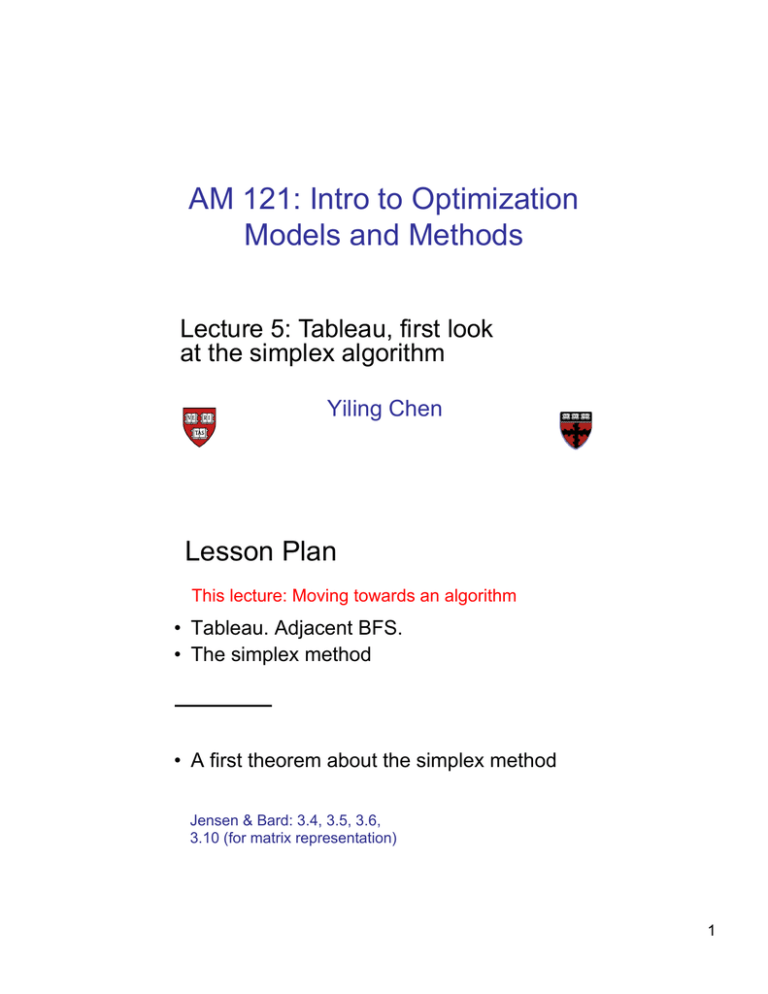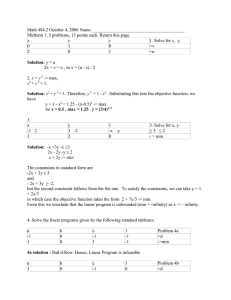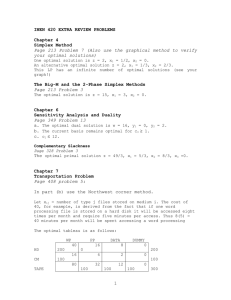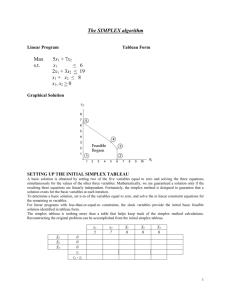To step 1 - Introduction to Optimization: Models and Methods
advertisement

AM 121: Intro to Optimization
Models and Methods
Lecture 5: Tableau, first look
at the simplex algorithm
Yiling Chen
TexPoint fonts used in EMF.
Read the TexPoint manual before you delete this box.: AAAAAAA
Lesson Plan
This lecture: Moving towards an algorithm
• Tableau. Adjacent BFS.
• The simplex method
• A first theorem about the simplex method
Jensen & Bard: 3.4, 3.5, 3.6,
3.10 (for matrix representation)
1
Warm-up
Canonical form
max cT x
s.t. Ax=b
x≥0
Equivalent canonical form
max z
s.t. z - cT x =0
Ax=b
x≥0
• We’re interested in constructing a tableau that
corresponds to a basis B
• Tableau is a system of equations
Example
• max
s.t.
• max z
s.t.
x 1 + x2
x1
x1 + 2x2
x 1, x 2,
+ x3
=2
+ x4 = 4
x 3, x 4 ≥ 0
z - x1 - x 2
x1
x1 + 2x2
x 1,
x 2,
+ x3
+ x4
x 3, x4
=0
=2
=4
≥0
• The tableau corresponding to basis {3,4} is:
z - x1 - x2
=0
x1
+ x3
=2
x1 + 2x2
+ x4 = 4
2
Tableau
max
z
s.t.
z - cT x =0
Ax=b
x≥0
• Definition. The tableau corresponding to basis B is a
system of eqns where basic variables are isolated.
• For basis B (with B’=N / B), the tableau is
z
+ c̄TB 0 xB 0 = v̄
IxB + ĀB 0 xB 0 = b̄
• Basic solution xB = b, xB’=0.
• Objective z = v
• Feasible when b ≥ 0.
• Parameters A, c, v, b different
from those without bar
(RHS can be negative!)
Constructing a Tableau
• Given a basis B, find tableau:
max z
s.t. z - cT x =0
z
Ax=b
IxB
x≥0
+ c̄TB 0 xB 0 = v̄
+ ĀB 0 xB 0 = b̄
a. Row operations to transform second row
Multiply by AB1
AB x B + AB 0 x B 0 = b
IxB + AB1 AB 0 xB 0 = AB1 b (*)
Let Ā0B = AB1 AB 0 and
b̄ = AB1 b
3
Constructing a Tableau
• Given a basis B, find tableau:
max z
s.t. z - cT x =0
z
Ax=b
IxB
x≥0
+ c̄TB 0 xB 0 = v̄
+ ĀB 0 xB 0 = b̄
b. Row operations to transform first row
use
Let c̄TB 0 = cTB AB1 AB 0
v̄ = cTB AB1 b
(*)
cTB 0 and
Example: Tableau (1/3)
(a)
• z - x1 - x2
=0
x1
+ x3
=2
(b)
x1 + 2x2
+ x4 = 4
(c)
• How obtain tableau for B={1,4}?
• Subtract (b) from (c); add (b) to (a):
• z
- x 2 + x3
= 2
x1
+ x3
= 2
2x2 - x3 + x4 = 2
• BFS? Objective?
• x=(2,0,0,2) ; z=2. An improvement!
x=(0,0,2,4)
B={3,4}
x=(2,0,0,2)
B={1,4}
4
Example: Tableau (2/3)
• z
- x2
x1
+ x3
= 2
+ x3
= 2
2x2 - x3 + x4 = 2
x=(2,0,0,2)
B={1,4}
How can we improve further?
Example: Tableau (2/3)
• z
- x2
x1
+ x3
= 2
+ x3
= 2
2x2 - x3 + x4 = 2
x=(2,0,0,2)
B={1,4}
How can we improve further?
• Increase x2 := t; keep x3=0; z= 2+t
5
Example: Tableau (2/3)
• z
- x2
x1
+ x3
= 2
+ x3
= 2
2x2 - x3 + x4 = 2
x=(2,0,0,2)
B={1,4}
How can we improve further?
•
•
•
•
Increase x2 := t; keep x3=0; z= 2+t
Feasibility: x1=2 ; x4=2 – 2t.
Set x2 := 1, because x4 < 0 for t >1.
New basis B={1,2}. x=(2,1,0,0), z=3.
Example: Tableau (3/3)
• z
- x2
x1
+ x3
= 2
+ x3
= 2
2x2 - x3 + x4 = 2
(a)
(b)
x=(2,0,0,2)
B={1,4}
(c)
Get tableau for B={1,2}
• z +
x1
+ ½ x 3 + ½ x4 = 3
+ x3
= 2
x 2 - ½ x3 + ½ x4 = 1
x=(2,1,0,0)
B={1,2}
• Obj coeff of nonbasic vars >= 0. Solution optimal!
• Must have z = 3- ½ x3 – ½ x4 ≤ 3 for any feasible
solution, since x3, x4 ≥ 0.
6
From Basis to Tableau and Back
• Theorem. If set B is a basis for matrix A then
there is a tableau corresponding to B. If there
is a tableau for set B then B is a basis for A.
• Proof
(è) perform row operations to isolate the variables
xB (possible since AB is invertible)
(ç) easy, B is a basis because AB=I and therefore
spans and is invertible.
Adjacent Bases
• Definition. Two bases for matrix A are
adjacent if they share all but one column
• Example
• max z = x1 + x2
• s.t.
x1
x1 + 2x2
x 1,
x 2,
+ x3
+ x4
x 3, x4
=2
=4
≥0
• Five bases {1,2}, {1,3}, {1,4}, {2,3}, {3,4}.
• B={1,2} is adjacent to {1,3}, not {3,4}.
7
The Simplex Method
Work in tableau form
• Step (i). Find an initial BFS.
• Step (ii).
Next lecture
– Determine if current BFS is optimal.
– If not, find an adjacent BFS with a larger z-value.
• Step (iii). Return to step (ii), using new BFS
as the current BFS.
How fast is this?
• Number of possible BFS is “n choose m”
nC
•
20C
m
= n! / (n-m)! m!
10=184,756
• Even if we can avoid cycling… gets large.
– “Degeneracy” leads to concern about cycling
– Next lecture
8
Empirical performance
The Simplex Method
• Work with:
•
•
•
•
•
•
max z
s.t. z - cTx = 0
Ax=b, x≥0
Step 0. Initialization
Step 1. Check optimality.
Step 2. Choose entering index.
Step 3. Check unboundedness.
Step 4. Choose leaving index.
Step 5. Pivot to a new tableau. To step 1.
9
Simplex Method - Overview
• max
s.t.
z
z
xi
+ ∑j 2 B’ cj xj = v
+ ∑j 2B’ aijxj = bi
(i2B)
• Step 0. Initialization (find a BFS and tableau)
• Step 1. If cj ≥ 0 for all j2B’, stop (optimal)
• Step 2. Pick entering index k2B’ with ck<0.
• Step 3. If aik ≤ 0 for all i2B, stop (unbounded)
• Step 4. Ratio test. t* = min{ bi/aik : i2B, aik>0}. Pick
leaving index r2B with min ratio.
• Step 5. Pivot on (r,k) entry to get a tableau for
B:=B[{k}\{r}.
Example of Simplex
z - x1 - x2
=0
x1
+ x3
=2
x1 + 2x2
+ x4 = 4
Basic x3 x4
Ratio 2/1 4/1
z
- x 2 + x3
=2
x1
+ x3
=2
2 x2 - x3 +x4 = 2
Basic x1 x4
Ratio
2/2
+ ½ x 3 + ½ x4 = 3
x1
+ x3
= 2
x2 – ½ x3 + ½ x4 = 1
Basic x1 x2
z
x1 to enter. x3 to leave
x2 to enter. x4 to leave
Reduced costs all nonnegative.
Stop
• Solution: (x1,x2,x3,x4)=(2,1,0,0), z=3.
10
Step 0: Initialization
• Find a basis corresponding to a BFS
– Details next lecture
• Construct the tableau for this basis
Step 1: Check optimality
• If cj ≥ 0 (for all j in B’) then stop, current
solution is optimal.
• Value z = v. Any feasible solution satisfies
z = v - cTxB’ ≤ v,
since c ≥ 0 and x ≥ 0.
11
Step 2: Choose Entering Index
• Pick some k in B’ with ck<0 to enter the
basis, so that the obj value increases with xk
• Say that ck is the “reduced cost” of nonbasic
variable xk. Amount by which z decreases
when xk increases (and so ck<0 is good).
Step 3: Check Unboundedness
• xi + ∑j 2 B’ aijxj = bi
(for all i 2B)
• Because other nonbasic vars = 0, we can
increase xk while:
xi = bi – aik xk ≥ 0
(for all i B) 2
• If aik ≤ 0 for every i in B, then xk can increase
without bound! Stop: objective value is
unbounded.
12
Step 4: Choose Leaving Index
• Need: xi = bi – aik xk ≥ 0; and so xk ≤ bi / aik
(where aik > 0).
• Ratio test: t* = min{ bi/aik : i in B, aik>0}
• Let R denote basic vars with min ratio
• Pick some r in R as leaving index; set xk := t*
• New basic variable xk “kicks out” the
“removed” variable xr
Step 5: Pivot to new tableau
• Definition. A pivot on variable xk in row
corresponding to xr is row operations to construct
tableau for B:=B[{k}\{r}.
• (a) Divide row xr + ∑j 2B’arjxr=br through by ark so
that coefficient of new basic variable xk becomes 1.
(Why does RHS remain nonnegative?)
• (b) Add/subtract multiples of this adjusted row to all
other equations (including objective) to remove xk
(Why do these operations not affect coeffs for other basic vars?)
13
From “method” to algorithm:
• Need to make precise remaining design choices
• Choice of entering index:
– most negative reduced cost: choose k2B’ with smallest ck
– smallest subscript: choose smallest index k2B’ with ck<0
– random: choose any k2B’ with ck<0
• Choice of leaving index: (may be a tie)
– smallest subscript: choose smallest index r 2R
– random: choose any r2 R
• These details matter; e.g., to prevent cycles
– next lecture
Degeneracy
• For now we assume this doesn’t happen, but
(looking ahead), we say a BFS is “degenerate”
if one or more basic variables have value zero.
• In this case, t* = 0 and simplex cannot make the
entering variable increase in value.
• Rather, simplex considers an adjacent basis
without improving the objective.
14
Simplex Termination
• Theorem. If never reach a degenerate BFS, then the
simplex method terminates with an optimal solution,
or a proof of unboundedness.
• Proof. Suppose LP is not unbounded.
– In every iteration, by non-degeneracy, the value of the
entering variable xk:=t*>0, and objective strictly increases
– So, cannot visit same BFS twice, and because finite
number of BFS, simplex terminates. When it terminates
the solution is optimal.
– Note: If LP is unbounded, at some point must find this
during simplex.
Summary
• Tableau is system of eqns that correspond to
basis, and represent all details of LP
– Basic variables are isolated
– Simplex changes tableau when searching BFS
• Simplex pivots through adjacent BFS until
finds “unbounded,” or terminates with an
optimal solution (will provably terminate if
problem is non-degenerate).
• Simplex is fast in practice
15
Next lecture
• How to find a first BFS to initiate the method?
• How can we be sure the method terminates
even if it encounters degeneracy?
16




